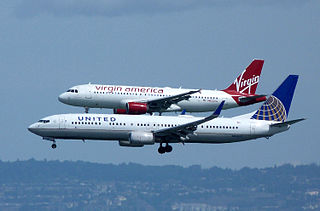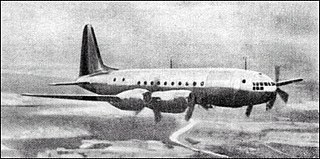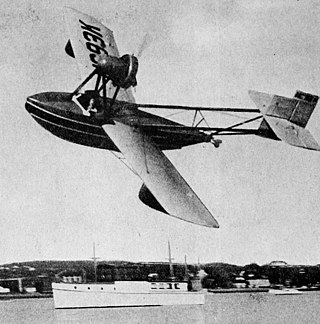
An airliner is a type of airplane for transporting passengers and air cargo. Such aircraft are most often operated by airlines. The modern and most common variant of the airliner is a long, tube shaped, and jet powered aircraft. The largest of them are wide-body jets which are also called twin-aisle because they generally have two separate aisles running from the front to the back of the passenger cabin. These are usually used for long-haul flights between airline hubs and major cities. A smaller, more common class of airliners is the narrow-body or single-aisle. These are generally used for short to medium-distance flights with fewer passengers than their wide-body counterparts.
A skeg is a sternward extension of the keel of boats and ships which have a rudder mounted on the centre line. The term also applies to the lowest point on an outboard motor or the outdrive of an inboard/outboard. In more recent years, the name has been used for a fin on a surfboard which improves directional stability and to a movable fin on a kayak which adjusts the boat's centre of lateral resistance. The term is also often used for the fin on water skis in the U.S. It has been used for the vertical fin on seaplane hulls and floats. The wear-bar on the bottom of snowmobile ski may also be called a skeg.

The Tupolev Tu-114 Rossiya is a retired large turboprop-powered long-range airliner designed by the Tupolev design bureau and built in the Soviet Union from May 1955. The aircraft was the largest and fastest passenger plane at that time and also had the longest range, at 10,900 km (6,800 mi). It has held the official title of fastest propeller-driven aircraft since 1960.

A snowmobile, also known as a snowmachine, motor sled, motor sledge, skimobile, or snow scooter, is a motorized vehicle designed for winter travel and recreation on snow. It is designed to be operated on snow and ice and does not require a road or trail, but most are driven on open terrain or trails. Snowmobiling is a sport that many people have taken on as a serious hobby. Common brand names in the United States include Arctic Cat, Polaris Inc. and Ski-Doo.

A hydrocopter is an amphibious propeller-driven catamaran with a boat-like hull, small wheels and pontoon skis. An aircraft engine with a propeller and air rudder powers the vehicle over water, ice, snow and land.

An airboat is a flat-bottomed watercraft propelled by an aircraft-type propeller and powered by either an aircraft or automotive engine. They are commonly used for fishing, bowfishing, hunting, and ecotourism.

An Aerosledge is a propeller-driven sledge, sleigh or toboggan which slides on runners or skis. Aerosleds are used for communications, mail deliveries, medical aid, emergency recovery, and patrolling borders in countries such as northern Russia, as well as for recreation. Aerosani were used by the Soviet Red Army during the Winter War and World War II.

The Piaggio P.136 was an Italian twin-engine amphibian flying boat designed and manufactured by aircraft company Piaggio Aero. It is furnished with an all-metal hull, pusher propellers, a gull wing, and retractable landing gear.

The Douglas DF was a commercial flying boat built by Douglas Aircraft Company, first flown on 24 September 1936.

The Siebel Si 202 Hummel ("Bumble-bee") was a German light sportsplane of the late 1930s. It was an angular low-wing monoplane, which could be powered by a variety of small engines.

The Blackburn C.A.15C Monoplane and Biplane were a pair of British aircraft intended to be as similar as possible apart from their wing arrangement. Tests in 1933 did not favour either design conclusively.

The Ilyushin Il-18 was a Soviet four-engined airliner designed and built by Ilyushin immediately after World War II. Although the aircraft itself was successful, its Shvetsov ASh-73TK engines were too unreliable for civilian use and were further needed to equip the Tupolev Tu-4 bomber, so it was cancelled in 1948.
The Fizir AF-2, Fizir 85 CV or Fizir-Vega was a two-seat amphibian intended for touring, sport and training.

The four-engined Lioré et Olivier LeO H-27 was one of three French flying boats competing to carry mail over Air France's South Atlantic routes. Flying later than its competitors, it was not selected and only one was built.
The S.A.B.C.A. S.XII or S.A.B.C.A S.12 was a four-passenger light transport aircraft with three engines and a high wing, built in Belgium in the early 1930s.

The Denhaut Hy.479 was a French flying boat flown in 1926 and intended to be suitable for commercial or military applications. Only one, in military configuration, was built and was sometimes known as the France-Aviation Denhaut.

The CAMS 54 was a strengthened and more powerful version of the French CAMS 51 civil transport and naval reconnaissance flying boat, developed for transatlantic flights. It is sometimes referred to as the 54 GR.

The Miami Maid was a US three passenger amphibian first flown in 1929. Despite ambitious production plans, only two were built.

The Ireland Privateer was a 1930s American two-seat, single pusher-engined monoplane sports flying boat which could be equipped as an amphibian. About 18 were built.

The Ireland Neptune was a four or five place pusher configuration biplane sold in flying boat and amphibian versions. Designed in the U.S. and first flown in 1927, well over 50 were built.

















